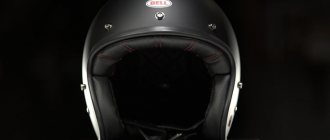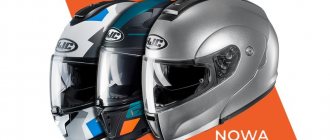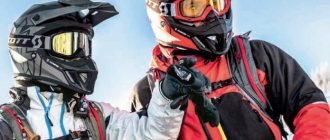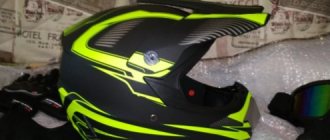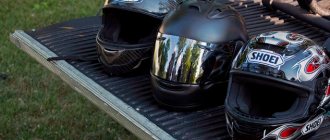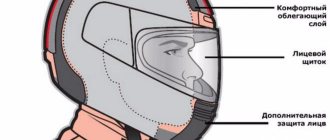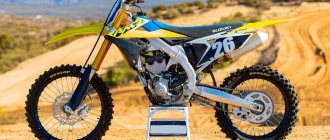One of the most important pieces of equipment for an ATV driver is a helmet, which increases the rider’s safety in the event of an accident. It should not only be durable and reliable, but also comfortable. Therefore, the owner of the equipment needs to select a model of a suitable configuration. The good technical condition of an ATV helmet should not be in doubt.
There are three main types of ATV helmets on sale:
- Open.
- Three quarters.
- Completely closed.
Winter and children's helmets for ATVs are divided into separate categories.
Features of an open-face helmet for an ATV
Relatively inexpensive, lightweight and comfortable helmets, the disadvantage of which is the low degree of driver protection. The lower part of his face is not protected by anything, so these models are suitable for beginner riders who try to avoid high speeds and difficult trails.
Such products are equipped with special eye protection. The size of the transparent shield (visor) covering the face depends on the model. In some helmets it covers only the eyes, but there are products with protection up to the chin.
8 Acerbis Profile Skinviper 3.0
The Italian inexpensive Acerbis Profile Skinviper 3.0 motorcycle helmet is perfect for riding ATVs or off-road sports bikes. The thermoplastic shell is quite reliable. Of course, it is not carbon fiber, but it has all the necessary safety certificates required by the EU. The visor is quite practical, has adjustment and perforation, thanks to which wind currents blow away any dirt that has fallen from it.
The helmet itself also contains ventilation channels, which provide good ventilation of the inner shell when riding a motocross motorcycle quickly. By the way, it is made of hypoallergenic material and can be easily removed for regular washing. The helmet is quite light, its weight barely reaches 2 kg (weight may vary slightly depending on the size). Attractive bright color and affordable price are a significant advantage of this model, especially for novice motorcycle racers.
Three-quarter models
Helmets that are closed to three quarters are also called cross helmets. They protect the ATV driver better than open models. The design provides a powerful arch that covers the lower part of the face. These helmets almost never have a visor. Instead, riders use special glasses.
In cross-country models, an important detail is the sun visor. When seated vertically, it protects the driver's eyes. In most cases, modern riders choose motocross helmet models.
What helmets are suitable for a child?
Along with the purchase of an ATV, parents think about how to choose the right children's protective helmet for an ATV. Among the variety of helmets for children, you should choose the following models.
Cross helmet
A cross helmet can be recognized by its long visor and reinforced chin section. The visor will protect you from the sun, dirt and branches, and the lower part will protect the child’s jaw from impacts, for example, on the steering wheel - this often happens to children. Also, due to the fact that the lower part of the helmet has an elongated shape, there is enough space for free air circulation. It will be easier for the child to breathe during physical activity.
A children's ATV helmet is essential for the child's safety.
A motocross helmet does not have a visor, so you can buy motocross goggles separately; the helmet has special recesses for them. More expensive models provide an additional ventilation system, the option of removal without damaging the neck, and shock damping.
Integral
The children's integral is similar to the cross bike, only it has a protective visor. The disadvantages of such a helmet are a narrower view and quick fogging of the glass. There is less air in it and it becomes stuffy faster, but driving at speed usually solves this problem. An undoubted advantage is the increased protection for the back of the head and chin.
Modular
Unlike the integral, the modular has a more movable design - without removing the helmet from your head, you can lift the visor together with the lower part or separately. This is convenient during short stops. A modular helmet weighs more, which can cause a child to get tired faster. But this model has an increased level of safety, improved ventilation, excellent sound insulation, and is warmer in winter. There are many additional interesting options, for example, airflow adjustment or a rear view camera.
The disadvantages of modular are its high price, greater weight, and mandatory maintenance of the mechanism.
There are a number of parameters you need to pay attention to when choosing a children's helmet.
Fully enclosed models
Closed helmets for ATVs have integrals and modulars and are used for road all-terrain vehicles. In size, such models coincide with the class by three quarters. However, closed models weigh more and also provide high driver safety when driving at high speeds.
The products also protect against noise, cold and wind, small solid particles, and midges. These models are not suitable for off-road driving. All their positive qualities appear only when moving along the highway. They do not have a sun visor, the viewing angle is smaller, and the ventilation is much worse. It is also impossible to quickly clean the visor from adhered dirt.
Popular brands
Domestic and foreign industry develops and produces a large number of models of motorcycle helmets, including those for ATVs. We offer a number of products with technical characteristics that are most highly rated by domestic users.
AFX FX39 SE
Winter American model with a removable visor. Removable options are also provided for the visor and the breath cutter with adjustment. The helmet has nine-channel ventilation, which allows you to create comfortable conditions in all weather conditions. The visor is heated and has UV protection. The outer covering of the helmet consists of durable composite materials. Inside the product there is a hypoallergenic lining that can always be removed and washed.
AGV Pista Gp R Agv Glossy Carbon
The helmet has the maximum degree of protection; it is capable of distributing the inertial pressure from an impact over the entire surface, while minimizing it. Drivers are pleased with the wide viewing angle. The comfortable fit of the helmet allows you to not notice it while riding. The only disadvantages include the high cost of the product.
ICON VARIANT DOUBLE STACK
The American-made helmet is a heavy-duty product. The streamlined shape of the visor copes well with its purpose, protects from sunlight and protects the visor from the encroachment of stones and dirt. The model provides the ability to change the visor glass, choosing between tinted and transparent options. Multi-channel ventilation works great. The outlets remove moist air into the external environment, preventing the glass from fogging up.
SHARK RIDILL THREEZV MAT KWG
The French model has optimal ventilation capabilities, a durable helmet surface, and a reliable visor, 2.2 mm thick. Fastenings are removed quickly, without delay. The helmet lining is made of microfiber and is machine washable. Unfortunately, there are complaints about the rapid wear of the lining material. The disadvantages include a narrow viewing angle, as well as excess weight.
SHARK EVO-ONE 2
The helmet from French developers has a high degree of safety and convenience. The thermoplastic body is manufactured taking into account the latest scientific advances. The product can easily be transformed from an open version to an integral model. An adjustable grille in front of the helmet complements the airflow, adding comfort to the operation of the ventilation system. The protective filter is lowered if necessary, darkening the transparent glass.
ARAI QV-PRO GoldWing
The helmet has excellent aerodynamic characteristics due to larger air intakes and longer channels. The visor with an enlarged cut-off is protected from ultraviolet rays. Users note the good quality of the product and the reliability of the case.
SHOEI J-CRUISE
Semi-open helmet model from a Japanese manufacturer. Multi-directional fiberglass and carbon fibers provide maximum strength to the helmet. The model has a wide range of visibility, two types of visor, easily changed using a simple slider. The product is available in different colors, and even with a graphic image.
IXS HX91
The developer of this model is Switzerland. They managed to create one of the best helmets used in hot climates. The product is intended for walking or slow driving over rough terrain. The light weight of the helmet coupled with the increased strength of the composite materials is captivating. The inner lining has bactericidal properties and is able to take an anatomical shape.
Children's helmets
Helmets made for young riders do not differ in safety and comfort from models for adult drivers. The difference is only in size and some design features.
Often, such helmets are supplied with children's ATVs. If the child is the right size, then you can use a standard helmet. Otherwise, you will need to choose another children's motorcycle helmet for an ATV, in which the child will be comfortable and safe. Models for children are much cheaper. When choosing a helmet, you need to have your child try it on. Buying a model “for growth” and, especially, without trying it on, is strictly prohibited. We must not forget that the safety of a young rider depends on the helmet.
Winter models
In the harsh domestic climate in winter, a comfortable and warm motorcycle helmet is required. The ideal solution would be closed models. When using cross or open helmets, it is recommended to wear an insulated balaclava underneath. However, such a solution will not be able to protect the surface of the visor from condensation, which reduces visibility on the road. The surface first fogs up and then freezes.
Therefore, there are various winter helmets on sale, which differ from summer models in the presence of high-quality thermal insulation and heated visor.
Features of choosing a helmet for an ATV
When deciding which helmet to choose for your ATV, it is worth noting that it is extremely important to do three things before purchasing the model you like:
- Try on a helmet.
- Determine what material the model is made of.
- Find information about the service life of the helmet.
First of all, you should pay attention to the material from which the piece of equipment is made. It can be plastic or composite. In the first case, the outer layer is made of monomaterial. The cost of such a helmet is lower, but its weight is greater. A composite is a material consisting of a large number of components. They make the helmet lighter and increase its strength. However, composite products are more expensive than plastic models.
Helmets from well-known brands have a stamp with a release date that you need to pay attention to. The materials from which personal protective equipment is made have their own “lifetime”. Even if the helmet has not been used, it gradually loses its protective qualities. After the expiration date, it cannot be used, since the protective properties have significantly decreased.
Little-known brands that produce cheap products do not indicate the release date or expiration date of the helmet. Therefore, if a product has such a seal, it can be considered high quality.
How to meet the necessary requirements
The helmet consists of an inner and outer shell, strap, visor and liners. Elimination of these problems is solved using special materials and manufacturing design. The material used is lightweight and durable Kevlar, which can withstand the impact of bullets and shrapnel.
But this is not enough, Kevlar will only save you from the physical impact of a blow. To dampen the wave and collision impulse, which can damage the brain from inertia, special shock-absorbing materials located in the inner layer are used. The thicker it is, the safer it is for you. In addition, these materials are able to withstand hypothermia in winter and have sufficient ventilation to promote comfort when driving in hot weather.
More expensive models are equipped with a visor of a darkened or simple transparent color, which protects against dust, water and dirt, and heating, which is necessary in cold times, preventing fogging.
When choosing, be sure to pay attention to the strap. Before that, it can be inconvenient to use. Choose quality.
How to do a fitting?
A helmet is not a fashion accessory, but a means of personal protection. Therefore, it is strictly not recommended to purchase it without trying it on, for example, through an online store. Helmets are available in different sizes. However, to determine whether the driver is comfortable, you must try on the model you like. To improve protective functions, the helmet should fit the head very tightly.
The fit model cannot be removed very easily. Over time, the seal will shrink, so if it did not initially fit your head tightly, the gap will subsequently become larger. Wearing such a helmet will not only be uncomfortable, but also unsafe.
How to choose a helmet for an ATV and fit it on correctly? You need to perform several sequential actions:
- Put on the helmet so that its edge is visible in the upper field of vision.
- Tighten the chin strap as far as possible.
- Holding the helmet with both hands, you need to try to move it back, forward and to the sides. It should not be loose, otherwise you need to choose a smaller size.
Choose depending on size
The most important criterion that will help you decide on the product you need is the circumference of your head. To do this, arm yourself with a measuring tape, stand up straight, the measurement should be taken in the area just above the eyebrows. Compare the results obtained with the helmet manufacturer’s sizing chart. Each number corresponds to a specific size, for example, S – 55-56, M – 57-58. However, keep in mind that these parameters may differ between different manufacturers. Therefore, be sure to try on equipment carefully before purchasing.
Advice! Correct fitting of a helmet is as follows: take the accessory in your hands, hold on to both straps, slightly stretching them in different directions. Then put the helmet on your head, while maintaining an upright position; you should not lean forward.
How to determine that the equipment fits correctly?
- The ears are in the correct position - if you feel discomfort, in particular, the ears are uncomfortable, try lifting the helmet and twisting it in different directions. Better yet, use a balaclava. Firstly, it will provide additional convenience, and secondly, it will provide additional hygiene to your head.
- The equipment should sit firmly on the head, without wobbling. To check this point, simply rotate your neck, tilt forward and backward - the helmet should not rotate and should not sit too loosely.
- Ease of use – despite the fact that the accessory must be held tightly, wearing it is always accompanied by comfort. No pressing sensations should be felt, blood flow is not impaired and no pain is present either. To figure it out, walk around with a helmet on your head for about 15 minutes, during this period you will be able to accurately determine whether the product matches your head. But if there is pain from the straps on the cheeks, then there is no need to be afraid of this, since the straps are able to take on the anatomical shape of the user’s skull over time.


